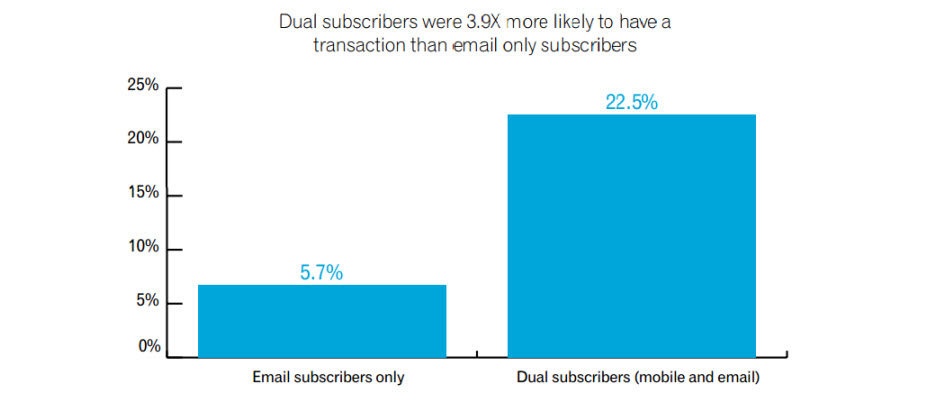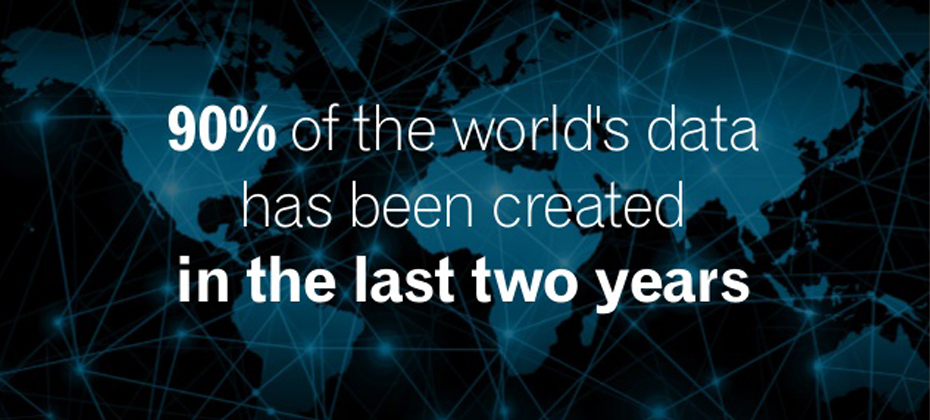Data & Analytics

While mobile subscriber lists typically are much smaller than email lists, mobile subscribers tend to be loyal and highly engaged customers.

As Big Data becomes the norm in the credit industry and others, the seemingly non-stop efforts to accumulate more and more data leads me to ask the question - when is Big Data too much data? The answer doesn’t lie in the quantity of data itself, but rather in the application of it – Big Data is too much data when you can’t use it to make better decisions. So what do I mean by a better decision? From any number of perspectives, the answer to that question will vary. From the viewpoint of a marketer, maybe that decision is about whether new data will result in better response rates through improved segmentation. From a lender perspective, that decision might be about whether a borrower will repay a loan or the right interest rate to charge the borrower. That is one the points of the hype around Big Data – it is helping companies and individuals in all sorts of situations make better decisions – but regardless of the application, it appears that the science of Big Data must not just be based on an assumption that more data will always lead to better decisions, but that more data can lead to better decisions – if it is also the “right data”. Then how does one know when another new data source is helping? It’s not obvious that additional data won’t help make a better decision. It takes an expert to understand not only the data employed, but ultimately the use of the data in the decision-making process. It takes expertise that is not found just anywhere. At Experian, one of our core capabilities is based on the ability to distinguish between data that is predictive and can help our clients make better decisions, and that which is noise and is not helpful to our clients. Our scores and models, whether they be used for prospecting new customers, measuring risk in offering new credit, or determining how to best collect on an outstanding receivable, are all designed to optimize the decision making process. Learn more about our big data capabilities

According to a recent Experian Marketing Services study, informational or "thanks for joining" messages drive significantly higher open and transaction rates than promotional emails, as well as higher revenue per email.

By: Barbara Rivera Every day, 2.5 quintillion bytes of data are created – in fact, 90% of the world’s data was created in only the last few years. With the staggering amount of data available, we have an unprecedented opportunity to uncover new insights and improve the way our world functions. The implications of these new capabilities are perhaps nowhere else as crucial as within our government. Public sector officials carry the great responsibility of conducting complex missions that directly affect our communities, our economy, and our nation’s future. The ability to make more informed, insightful choices and better decisions is paramount. Especially at a time of broader global unrest and uncertainty, Americans rely on our government to be transparent, fair, ready and to make the right decisions – our trust is in the hands of our elected officials and public servants. Data alone is not enough to inform and affect change. However, with integrated information assets, insightful analysts and collaborative processes, data can be transformed into something meaningful and actionable. Our government has already begun leveraging data for good across agencies and varied missions, with more potential unlocked each day. Local governments like Orange County, California are utilizing data through address verification services to keep their voting lists accurate – ensuring the integrity of elections and saving the taxpayers thousands of dollars otherwise wasted on mailings to outdated lists. The Orange County Registrar of Voters – the fifth largest voting jurisdiction in the county – has been able to cancel 40,000 voting records, with an estimated savings of $94,000 expected from 2012 through 2016. The examples are numerous and growing: A suite of optimization tools helps states find non-custodial parents, determine their capacity and likelihood to pay child support, and trigger alerts with new critical information, maximizing the likelihood of payment and recovery, ultimately improving the welfare of children and reducing poverty More than 150 state, county and local law enforcement agencies leverage data to help identify persons of interest, conduct background screening for employees and contractors and provide financial backgrounds for criminal investigations, ensuring our continued safety By using the power of data to manage user authentication, credentials and access controls, the government is working harder – and smarter – to protect our security The government is leveraging verified commercial data to help agencies validate the fiscal responsibility of potential contractors and monitor existing contractors, which helps provide transparency and reduce risk By using data and analytics to authenticate applicants and validate financial data, the government is ensuring access to benefits for those who meet eligibility requirements, while at the same time reducing fraud Private sector partners are supporting municipal efforts to improve financial stability in households by providing the current credit standing of consumers and monitoring overall changes in financial behaviors over time, to help counsel and educate citizens And that’s only the beginning. The possibilities are endless – from healthcare to finance to energy – data can be leveraged for the advancement of our society. It even happens behind the scenes, working to protect information in ways most citizens never realize. Data insights are used to ensure citizens have secure online access to their information – ever see those randomized, personal questions? That’s data at work. The same technology is the de facto ID Proofing standard for the VA and CMS. How does it all work? By combing through the data carefully, putting it in context, looking at it in new ways, and thinking about what all this information really means. Much of this is made possible through public-private partnerships between the government and companies like Experian. So the next time someone complains about the slow pace of government, let them know the truth is government is moving quickly, leveraging data and private sector partnerships to uncover new insights that impact the greater good.

This season’s peak week, the Wednesday before Thanksgiving through the Tuesday after Cyber Monday, had an 18 percent increase in email volume, an 11 percent rise in transactions and a 7 percent increase in email revenue in comparison to peak week 2013. Cyber Monday provided 27 percent of total peak week revenue followed by Black Friday, which accounted for 18 percent of revenue. Marketers can design more successful holiday campaigns by staying on top of the latest email trends. View the December Holiday Hot Sheet

According to a recent Experian Data Quality study, three out of four organizations personalize their marketing messages or are in the process of doing so.

According to Experian Marketing Services’ Q1 2014 Email Benchmark Report, personalized abandoned cart emails that dynamically show the actual customer cart had 25 percent higher transaction rates than reminder emails that just linked back to the brand’s Website.

As part of its guidance, the Office of the Comptroller of the Currency recommends that lenders perform regular validations of their credit score models in order to assess model performance.

According to Experian Marketing Services' annual Email Market Study, personalized promotional emails have 29 percent higher unique open rates and 41 percent higher unique click rates than nonpersonalized mailings.

Using a risk model based on older data can result in reduced predictive power.

The volume of emails sent by marketers rose nearly 13 percent during the 2013 holiday season compared to 2012.

As we prepare to attend next week’s FS-ISAC & BITS Summit we know that the financial services industry is abuzz about massive losses from the ever-evolving attack vectors including DDoS, Malware, Data Breaches, Synthetic Identities, etc. Specifically, the recent $200 million (and counting) in losses tied to a sophisticated card fraud scheme involving thousands of fraudulent applications submitted over several years using synthetic identities. While the massive scale and effectiveness of the attack seems to suggest a novel approach or gap in existing fraud prevention controls, the fact of the matter is that many of the perpetrators could have been detected at account opening, long before they had an opportunity to cause financial losses. Synthetic identities have been a headache for financial institutions for years, but only recently have criminal rings begun to exploit this attack vector at such a large scale. The greatest challenge with synthetic identities is that traditional account opening processes focus on identity verification compliance around the USA PATRIOT Act and FACT Act Red Flags guidance, risk management using credit bureau scores, and fraud detection using known fraudulent data points. A synthetic identity ring simply sidesteps those controls by using new false identities created with data that could be legitimate, have no established credit history, or slightly manipulate elements of data from individuals with excellent credit scores. The goal is to avoid detection by “blending in” with the thousands of credit card, bank account, and loan applications submitted each day where individuals do not have a credit history, where minor typos cause identity verification false positives, or where addresses and other personal data does not align with credit reports. Small business accounts are an even easier target, as third-party data sources to verify their authenticity are sparse even though the financial stakes are higher with large lines of credit, multiple signors, and complex (sometimes international) transactions. Detecting these tactics is nearly impossible in a channel where anonymity is king — and many rings have become experts on gaming the system, especially as institutions continue to migrate the bulk of their originations to the online channel and the account opening process becomes increasingly faceless. While the solutions described above play a critical role in meeting compliance and risk management objectives, they unfortunately often fall short when it comes to detecting synthetic identities. Identity verification vendors were quick to point the finger at lapses in financial institutions’ internal and third-party behavioral and transactional monitoring solutions when the recent $200 million attack hit the headlines, but these same providers’ failure to deploy device intelligence alongside traditional controls likely led to the fraudulent accounts being opened in the first place. With synthetic identities, elements of legitimate creditworthy consumers are often paired with other invalid or fictitious applicant data so fraud investigators cannot rely on simply verifying data against a credit report or public data source. In many cases, the device used to submit an application may be the only common element used to link and identify other seemingly unrelated applications. Several financial institutions have already demonstrated success at leveraging device intelligence along with a powerful risk engine and integrated link analysis tools to pinpoint these complex attacks. In fact, one example alone spanned hundreds of applications and represented millions of dollars in fraud saves at a top bank. The recent synthetic ring comprising over 7,000 false identities and 25,000 fraudulent cards may be an extreme example of the potential scope of this problem; however, the attack vector will only continue to grow until device intelligence becomes an integrated component of all online account opening decisions across the industry. Even though most institutions are satisfying Red Flags guidance, organizations failing to institute advanced account opening controls such as complex device intelligence can expect to see more attacks and will likely struggle with higher monetary losses from accounts that never should have been booked.

By: Wendy Greenawalt On any given day, US credit bureaus contain consumer trade data on approximately four billion trades. Interpreting data and defining how to categorize the accounts and build attributes, models and decisioning tools can and does change over time, due to the fact that the data reported to the bureaus by lenders and/or servicers also changes. Over the last few years, new data elements have enabled organizations to create attributes to identify very specific consumer behavior. The challenge for organizations is identifying what reporting changes have occurred and the value that the new consumer data can bring to decisioning. For example, a new reporting standard was introduced nearly a decade ago which enabled lenders to report if a trade was secured by money or real property. Before the change, lenders would report the accounts as secured trades making it nearly impossible to determine if the account was a home equity line of credit or a secured credit card. Since then, lender reporting practices have changed and, now, reports clearly state that home equity lines of credit are secured by property making it much easier to delineate the two types of accounts from one another. By taking advantage of the most current credit bureau account data, lenders can create attributes to capture new account types. They can also capture information (such as: past due amounts; utilization; closed accounts and derogatory information including foreclosure; charge-off and/or collection data) to make informed decisions across the customer life cycle.